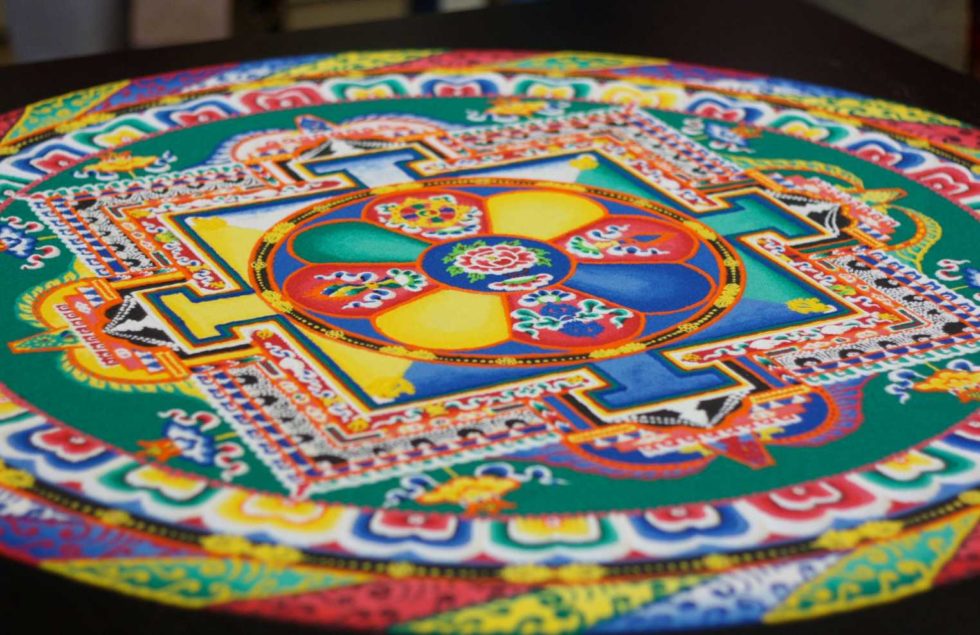The Mandala represents a realm where all elements are in balance, bringing a deep sense of peace and beauty to our world. It conveys an external structure that can also be reflected internally, in our minds. In this way, it shows a macrocosm and microcosm, at one and the same time a universe in perfect harmony and our minds in perfect balance.
Structures of the Mandala
An outer ring of five-colored flames represents the five types of wisdom. It shows that we are entering a sacred realm as we proceed into the mandala.
Next is a ring of vajras, which represent spiritual power and protection.
A ring of multicolored lotus petals comes next, signifying the purity of the realm. A lotus grows in a muddy place in stagnant water, but emerges untouched and pure.
The inner parts of the mandala show a palace seen from above, as an architect would draw it. The basic structure of the palace is laid out on top of two crossed vajras that form a double vajra (Sanskrit) or double dorje (Tibetan), that symbolize balance.
All that is seen of the vajras is their outer curves and tips, which form the gateways into the palace. Often two deer with a wheel between them are placed on top of the gateways, symbolizing the teaching of the Buddha. The Buddha gave his first teachings in Deer Park in Sarnath, India and it was said that even the deer came to listen to him teach. An umbrella above them symbolizes protection from the heat of desire.
Next comes the five walls of the palace, each a different color. Within the walls, the inner courtyard is divided into four different quadrants in four colors. These represent the four cardinal directions, starting at the bottom with east (white), and going clockwise to find south (yellow), west (red), and north (green). The fifth direction in the Tibetan system is the center (blue). The zenith is the highpoint above the mandala, the nadir is at the depth below.
In the center of the mandala is a circular lotus throne on which the central deity will reside. Sometimes a symbol such as a vajra will replace the deity it represents, in this case Buddha Akshobhya, who holds a vajra. Often there will be other deities placed on top of the lotus petals, representing a retinue of the associated deities.
The Five Directions
The five directions and the five colors associated with them provide a guide to the basic concepts of Tibetan art. Each direction has not only a color and element associated with it, but also a negative emotions a type of wisdom that can counteract that emotion, a Dhyani (Meditation) Buddha, a symbol, and a Bodhisattva.
EAST: Starting at the bottom in the east is how we symbolically enter the mandala. The color is white; the element is water; the negative emotion is anger; the wisdom that counteracts anger is “Mirror-like Transcendent Wisdom’” the Buddha is Vairocana; the symbol he holds is the wheel; the Bodhisattva is Akashagarbha.
SOUTH: To the left is south. The color is yellow; the element is earth; the negative emotion is pride; the wisdom to counteract that is the “Transcendent Wisdom of Equanimity;” the Buddha is Ratnasambhava; his symbol is a jewel; the Bodhisattva is Kshitigarbha.
WEST: At the top of the mandala is west. The color is red; the element is fire; the negative emotion is greed; the wisdom to counteract it is “Transcendent Wisdom of Discrimination” that leads to compassion; the Buddha is Amitabha; the symbol is the lotus; the Bodhisattva is Avalokiteshvara.
NORTH: To the right of the mandala is north. The color is green; the element is air; the negative emotion is envy; the wisdom to counteract it is the “Transcendent Wisdom of All-Accomplishing Action;” the Buddha is Amoghasiddhi; there are two symbols: the double vajra and the flaming sword; the Bodhisattva is Sarvanivarana Vishkhambhin.
CENTER: In the center of the mandala the color is blue; the element is ether; the negative emotion is dullness or ignorance; the wisdom is the “Transcendent Wisdom of the Absolute Truth;” the Buddha is Akshobhya; the symbol is a vajra; the Bodhisattva is Vajrapani.
ZENITH: Above the mandala is the zenith. The color is white like a radiant diamond from which all colors emanate; the wisdom is the “Five-fold Transcendent Wisdom;” the Buddha is the primordial or Adi Buddha Vajradhara; his symbols are the bell and vajra, shown crossed at his heart; the Bodhisattvas are Manjushri and Maitreya.
NADIR: At the depth below the mandala is the nadir. The wisdom is also the “Five- fold Transcendent Wisdom;” the Buddha is the Adi Buddha,Vajrasattva; his symbols are the bell and vajra (the bell at his hip, the vajra at his heart); the Bodhisattva is Samantabhadra.

